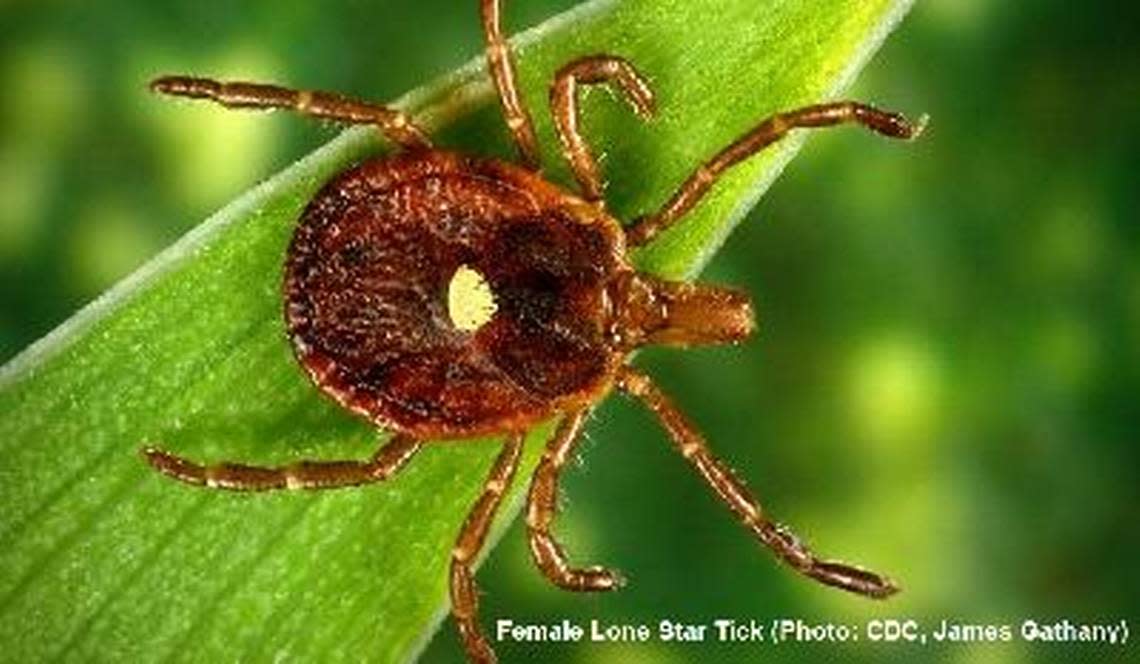It’s officially tick season in Kentucky. Here’s what you can do to protect yourself.

Longer days and warmer weather mean many Kentuckians spend this time of year on the trail, in their gardens and just outside more often.
Unfortunately this is also a busy time of year for an eight-legged nuisance with a penchant for blood sucking.
May is the beginning of Kentucky’s “high tick season,” said Jonathan Larson, an extension entomologist at the University of Kentucky. That season typically runs through July but people can encounter ticks at any time of year in the Bluegrass state — it’s just far more likely in the spring and summer.
“No matter how long you’ve been outside, if it was 20 or 30 minutes to weed the garden, if you went hiking for the whole weekend, you need to take precautions to keep yourself safe from ticks,” Larson said. “Unfortunately, they’re not going away.”
If you’re looking to get outside, check out these tips on how to stay tick safe in Kentucky.
How can I prevent tick bites?
Part of what makes these months high tick season is an explosion of growth in the thick, weedy areas they like to use for shade. That’s where ticks “like to hang out,” Larson said. Out for a stroll in the park? Simply staying on trail, away from overgrown areas, will offer some protection.
How you dress also goes a long way, Larson said. He advised wearing long pants and long sleeves. Level up that protection by tucking your pants into your socks or duct taping your pants at the bottom. Wearing light-colored clothing will also make any ticks hanging onto clothes easier to see.
Outside of clothing, spray-on repellents that contain chemicals like DEET, picaridin, IR3535 or oil of lemon eucalyptus will also make you less attractive to a hungry tick — and the also blood-thirsty mosquito. But of those chemicals, one reigns supreme, Larson said.
“DEET is the standby. DEET is the best,” Larson said, adding that the other products fill in the gap for those who don’t like DEET or have a sensitivity to it. They generally just don’t last as long or aren’t as effective.
Those looking to go deep into the woods for camping or hunting could also consider using an insecticide called permethrin — but don’t put it on your skin. Instead, apply it to your clothes and gear. If a tick crawls on a treated surface, the permethrin will kill them, Larson said.
How to check for ticks
When checking for ticks, Larson recommended paying close attention to a few tick hotspots. Those include your armpits, bellybutton, around the waist, in your groin area, behind the knees and around your ankles. Having a friend or loved one look in areas like your hair and behind your ears can also help.
Checking your cats and dogs — or any animal that has access to both the inside and outside of your home — is also highly recommended. Hitching a ride on our furry friends is a common way for ticks to enter the home.
Larson said it’s a “great idea” to get your animals treated with flea and tick medications. Regularly running a comb through their fur to be sure ticks aren’t embedding is also good practice.
Look out for the lone star tick and the mysterious virus it spreads, scientist says
What do I do if a tick bites me?
If you found a tick and it’s not “plugged in,” which means it’s just crawling around, Larson said to pick it up and find some way to destroy it. When ticks aren’t engorged, they’re hard to squish so many people flush them down the toilet or drop them into a container with rubbing alcohol.
If the tick is plugged in to the skin, grab a pair of fine-point tweezers. Get as close to the skin as possible and grab the tick’s head and “pull steadily backwards,” Larson said. Avoid wiggling or twisting the tick. Doing so could break off pieces in your skin.
Don’t use any of the commonly recommended home remedies for tick removal, like hitting it with a lit cigarette or pouring gasoline or even bourbon on it. “I’ve encountered that a few times,” Larson said.
Those methods could agitate the tick and they could “kind of barf into you,” Larson said. That could raise the chances for disease transmission.
If a tick has been on you for awhile and appears engorged, Larson recommended keeping the specimen after removal by putting it into a plastic container along with rubbing alcohol. Take it with you to the doctor if you get sick later.
“Then they can make an educated estimation on what you’ve possibly been exposed to pathogen wise, based on the species of tick,” Larson said.
What diseases are carried by ticks?
In Kentucky, the most common tick-borne illness is Rocky Mountain spotted fever, Larson said. Usual symptoms include fever, headache, vomiting, abdominal or muscle pain. A rash that starts on the ankles, wrists and forearms can also develop.
Multiple tick species active in the state can carry the disease, including the commonly found Lone Star tick. That tick can also spread red-meat allergy, which according to UK’s entomology department, is characterized by a rash or “anaphylactic reaction” occurring hours after eating red meat.
The entomologists at UK typically get the most questions about the infamous Lyme disease, Larson said. You can get that in the state but only the Blacklegged tick, also called the Deer tick, is known to carry the disease in Kentucky.
UK’s entomology department has a full run-down on what ticks are found in Kentucky on their website.
Found a tick? Mail it to this UK professor to see if it carries disease

